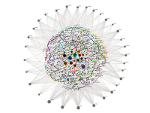 Outreach
Outreach
OUTREACH
Symposium on preference for curvature
Symposium: “The Human Aesthetic (and Moral) Nature: The preference for curvature”.
This symposium is part of the project “La naturaleza moral y estética humana. Caracterización sistemática de los rasgos derivados humanos de mora y estética”. In the project, there are different research lines, all of them related to aesthetics, morals, or both. One of these lines has been moved towards possible common evolutionary roots of aesthetics and morals. In this line, we followed the Johnson’s idea (2008, 2012) according to aesthetics and morals are not pre-categorized experiences, they are only categorized by the involvement of high cognitive processes, after particular interactions with the environment. Johnson understands that the categorization of these experiences and interactions, as aesthetic or moral, originally –from a phylogenetic viewpoint– happened in problem-solving situations. In other words and from an evolutionary perspective, problemsolving situations would be the behavioural origin of the traits of aesthetics and morals.
Then, the next question is about what kind of problem-solving situation Johnson is referring to. EvoCog researchers idea is that, in the case of aesthetics, these situations have to be related to primary needs that required or requires a quick response. These quick responses would have been automatized facing to particular stimulus configurations. Then, these particular stimulus configurations would have caused approach or withdrawal responses even in the absence of the original context. That is, these responses or reactions happened in dissociated contexts, without an immediate function. If this reasoning is right, the next step is to try to identify some of those stimulus configurations that initially produced quick adaptive responses, which later could be referred as “aesthetic responses”, when they lost its adaptive link. This is the reason why EvoCog began to research on the visual preference for curvature, the core of this meeting.
So, EvoCog have carried out several experiments to test the possibility that this preference were what the researchers have called an “aesthetic primitive”. Quite a few of our data pointed in this direction. However, researchers of EvoCog are a bit surprised by the amount of new questions, experiments and lines that have appeared as a consequence to look into this effect. These issues are beyond the phylogenetic perspective: comparative psychology, visual system, art and aesthetics, neuroscience, ergonomics, design, architecture, …Thus, the idea is to continue to research on this effect, beyond the current project that will end on December 31th.
The initial project had planned a final meeting about the general activities, but EvoCog researchers have decided to focus the meeting on this effect since it could give them a first empirical support of a particular hypothesis on the emergence of the human aesthetic trait, but it also could give them a wide array of possibilities, especially from a psychological perspective.
![]()
![]()














